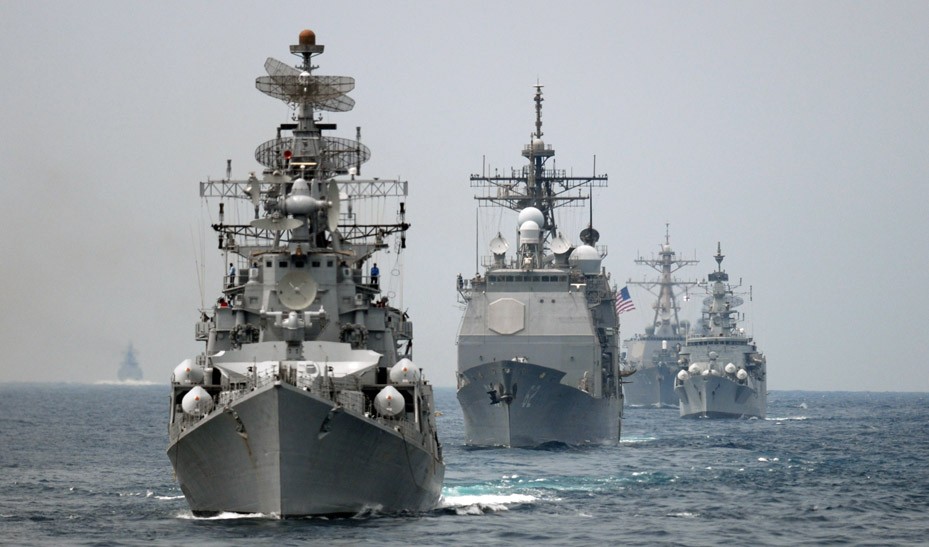
Seas and oceans have become nerve centres for contemporary financial sustenance of states

When a state is unable to secure safe maritime passage, triangulation of a strategic location for continuation of a policy becomes a maritime favourite. States with access to terrain can reduce amount of ‘strategic shock’ and maintain alternatives for a secure and uninterrupted bypass, rendering naval expenses and time consumed rather redundant. Furthermore, it tends to discourage further expeditions as naval deployments are painstakingly time consuming and require a constant supply line because ships can carry a very limited amount of firepower and resources to be put to use.
A more diverse approach is use of alliances as a means to maintain Sea Lines of Communications (SLOC) as well as an assured supply depot when needed in time of crisis. Then there are states that specifically are engaged in a land struggle, therefore their naval muscles are not as considerable as those who need oceans for their sustenance.
Triangulation is where a competitive adversary utilises its potential alliances to circumvent any attempts by its competing rival at breaking dominance. But thermonuclear weapons and Submarine Launched Ballistic Missile (SLBM) technology compensated for limitations on naval potential to exert damage. Even then, navy had to rely on battle-group formations and concentration of naval capabilities, which still required land support.
Korean peninsula has been subject of a lot of distraught international politics with both Beijing and Washington involved. Trump administration, after withdrawing from the Trans Pacific Partnership (TPP), held a firm stance on exacting irreparable damage on North Korea for any adventurism directed towards Japan or South Korea as well as against China on its Air Defense Identification Zone (ADIZ) following the Senkaku Island issue.
With Kim Jong Un signaling a more pulsating direction for North Korea’s plans on Korean peninsula, South Korea and America are engaged in joint ventures to repel any bellicosity. It seems that even though the Cold War had ended, the Far East Asian dimension still remains alive.
China and Russia maintain North Korea’s deterrence and the US-Japan-South Korea coalition maintain an effective maritime countermeasure complete with SLBMs and BMD systems. A noteworthy point, however, is America’s strong naval presence within and beyond this region and its effectiveness in maintaining a colossal navy supplemented with substantial assistance all across the globe.
Seafaring is more about avoiding than engaging and it is more to prevent than pursue but if the need arises, it is also about making sure there remains no prompt retaliation either through complete annihilation or preemption against an adversary. That is why nuclear submarines and aircraft carriers carry more firepower than most nuclear weapon states combined. One has the option of using allies in a way that they are pushing their agenda while one remains comfortably busy with other pressing issues and this delegation makes matters more manageable.
With contemporary aggression outweighing strategy for economy and maritime domains of the planet still residing with colonial era management of finances, aggression can take a whole new meaning. With China-Pakistan Economic Corridor (CPEC) and its One Belt One Road (OBOR) initiative, Seoul and Pyongyang remain relatively isolated which is not necessarily a good indicator. Not every missile tested by Pyongyang has been welcomed by its allies as they will eventually develop their own syndromes.
With Taiwan, Japan and Singapore asking questions about America’s ‘faithfulness’ to providing deterrence after Chinese ADIZ, ASEAN in geographical sense seems really upset. With China looking to blockade Indian Ocean by choking Hormuz through Arabian Sea, America trying to go at length to deny China the Strait of Malacca, North Korea vying to be a regional fortress, South Korea seeking assured extended nuclear deterrence from America; it is only the Atlantic Ocean what remains unquestionable.
Seas and oceans are nerve centers for contemporary financial sustenance of nations and that was the reason colonial era countries like Britain amassed considerable navy for their grip over continents but that navy neither had megatons stored in its missile tubes nor had such prolonged survivability for retaliation. The strategy was simple; if you could engage, engage and if you could not; escape. North Korea, Strait of Malacca, Strait of Hormuz, the Arabian Sea, Mediterranean Sea, Gulf of Aden and even the Bering Sea are what can be termed new nuclear flashpoints instead of conventionally believed regions like South Asia or North Africa or the Middle East because maritime trade volumes are humongous with almost all of the developed world solely relying on SLOCs for their chic existence in our world.
States depending dominantly on land based resources are also connected through an import and export structure. In a world full of submarines and guided missile destroyers and with states intentionally making sure that they ‘unintentionally’ restrict and deny their adversary a safe naval passage, it is not difficult to imagine that there is more threat on sea than on land.
Agreeing that land disputes and stalemates are hot pockets in global nuclear strategy but there is much to worry about at sea because seas are, and always have been, the most important resource worth fighting for.